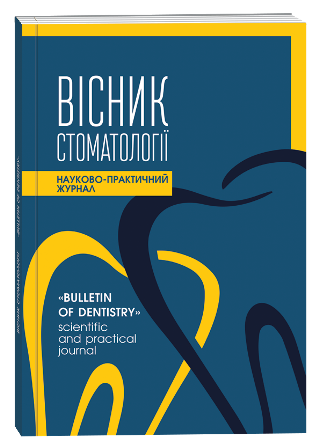RETROSPECTIVE ANALYSIS OF ALVEOLITIS AS A POST-EXTRACTION COMPLICATION IN DENTAL PATIENTS IN KHARKIV
DOI:
https://doi.org/10.35220/2078-8916-2025-55-1.2Keywords:
alveolitis, extraction, retrospective analysis, painAbstract
Purpose of the study. To study the structure, causes and frequency of alveolitis as a post-extraction complication, depending on the age and sex of patients, based on a retrospective analysis of outpatient records and journals of planned surgical interventions in the surgical departments of dental clinics in Kharkiv. Research methods. A retrospective analysis of 2 000 medical records of dental patients (form 043/o, approved by the Order of the Ministry of Health of Ukraine № 110 of 14 February 2012), logs of planned surgical interventions and other medical records containing information on the diagnosis, treatment and rehabilitation of patients with diseases of the dentition for 2022–2024, the archive database of surgical departments of dental clinics in Kharkiv was conducted. The following were studied and analysed: gender and age of patients, incidence of alveolitis as a post-extraction complication of surgery, incidence and causes of alveolitis depending on the group of the extracted tooth, severity of surgery, pain syndrome that occurred after surgery. Scientific novelty. The gender distribution of the sample of 2 000 patients who came for outpatient surgical dental care was carried out, of which women accounted for 60,7% (1 214 people) and men for 39,3% (786 people). The main type of intervention was tooth extraction, which was performed in 1 420 patients (71%), with a total of 1 624 extractions. Patients over 40 years of age accounted for 73% (1 460 people). Among all extractions, 81,2% were typical and 18,8% were complex. Alveolitis was diagnosed in 13,2% of cases (214 cases), mainly in women (55,3%) and in the mandible (67,5%). Alveolitis occurred more frequently after molar extraction (65,9%) and was accompanied by pain, including symptoms similar to trigeminal neuralgia (9%) or dental plexalgia (15%). Conclusions. 1. In 71% of patients who came for outpatient dental surgery, the main intervention was tooth extraction. 2. Alveolitis was diagnosed in 13,2% of all extractions. 3. The frequency and severity of the clinical course of alveolitis depended on the condition of the causative tooth, oral hygiene, age, gender, type of the surgical intervention and the severity of tissue trauma. 4. Pain sensitivity in alveolitis is caused by traumatic interventions in the dentoalveolar region, which can cause damage to the branches of the trigeminal nerve and the development of dental plexalgia. Symptoms similar to trigeminal neuralgia were observed in 9% of patients with alveolitis, and symptoms of dental plexalgia – in 15%. 5. The obtained results confirm the relevance of research on the prevention, differential diagnosis, treatment and rehabilitation of patients with post-extraction complications.
References
Fan W., Zhu X., He Y., Zhu M., Wu Z., Huang F., He H. The role of satellite glial cells in orofacial pain. Journal of neuroscience research. 2018. Т. 97. № 4. P. 393–401. URL: https://doi.org/10.1002/jn r.24341.
Товажнянська О.Л., Хлєбас С.В. Лицеві болі у стоматології. Oral and general health. 2021. T. 2. № 2. P. 36–42. URL: https://doi.org/10.22141/ogh.2.2.2021.237656.
Рошка Ю.О., Горицький Я.В., Гаген О.Ю. Альвеоліт: сучасний стан проблеми. Клінічна стоматологія. 2014. № 2. С. 53–56.
Хайтович М.В., Мазур І.П. Менеджмент хронічного постпроцедурного болю у стоматології. Oral and general health. 2020. T. 1. № 1. P. 17–24. URL: https://doi.org/10.22141/ogh.1.1.2020.214842.
Kämmerer P.W., Heimes D., Hartmann A., Kesting M., Khoury F., Schiegnitz E., Thiem D.G.E., Wiltfang J., Al-Nawas B., Kämmerer W. Clinical insights into traumatic injury of the inferior alveolar and lingual nerves: a comprehensive approach from diagnosis to therapeutic interventions. Clinical oral investigations. 2024. T. 28. № 4. URL: https://doi.org/10.1007/s00784-024-05615-4.
Hasstedt K.L., Meyer R.A., Bagheri S.C. Nerve involvement in oral surgery. Innovative perspectives in oral and maxillofacial surgery. Cham, 2021. P. 327–342. URL: https://doi.org/10.1007/978-3-030-75750-2_36.
Shrestha R.K., Shrestha D., Sakya P.R., Khadka D., Shrestha R., Shrestha K. Anatomical risk factors of nerve injuries following surgical removal of mandibular third molar. Nepal journal of health sciences. 2022. T. 2. № 1. P. 46–54. URL: https://doi.org/10.3126/njhs.v2i1.47165.









